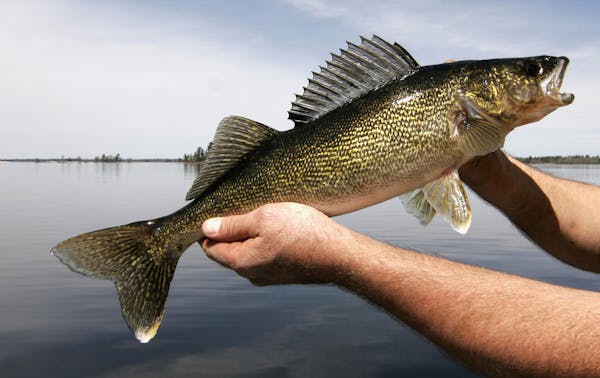When Gov. Mark Dayton fishes Gull Lake near Brainerd on Saturday, he might catch a walleye born not of its waters but conceived instead in a bowl and hatched in a jar — a product of the complex fisheries science that underpins the state's ambitious walleye stocking effort.
Count Department of Natural Resources fisheries section employees Mike Knapp and Owen Baird as two of the program's surrogate parents.
The other day, amid a spring chill that kept most people indoors, Knapp cradled a bulbous female walleye in his arms before leaning over a plastic bowl and stripping the fish of her eggs.
As quickly, Baird towered over the bowl and squeezed a male walleye of its sperm, or milt, fertilizing the eggs.
Like the other half-dozen or so workers at this DNR walleye egg collection site on the Pine River, an inlet to the Whitefish Chain of Lakes about 30 miles from Gull Lake, Knapp and Baird were layered in fleece and draped in rain suits.
While they stripped walleyes, their co-workers shuffled atop metal catwalks surrounding large, walleye-filled trap nets. Some brandished long dip nets, dividing male and female fish into separate holding areas.
This and similar egg collection and fertilization efforts at eight DNR sites statewide are the first steps in the state's nearly $4 million annual walleye stocking program. The effort is critical to maintaining what is widely believed to be the nation's best walleye fishery, even though an estimated 85 percent of the nearly 4 million pounds of walleyes caught by Minnesota anglers each year are wild.
"It's in everyone's interest to help natural production if we can," said Brainerd area fisheries supervisor Marc Bacigalupi. "Supplemental stocking reduces the possible adverse effects of periodic poor natural reproduction."
About 575 million eggs are collected each spring throughout Minnesota to bolster anglers' fortunes on the 1,000 state lakes where natural walleye reproduction is either sporadic or nonexistent.
And while some of Minnesota's big walleye "factories" such as Lake Mille Lacs aren't stocked, others of the state's storied walleye waters are. This includes 9,400-acre Gull, which — even though it has held walleyes dating to before white settlement — annually receives about 3 million mosquito-sized "fry."
Other noted walleye waters near Brainerd that are stocked either annually or semiannually include Pelican, North Long, Round and the Whitefish Chain.
At the DNR's Pine River station, eggs captured and fertilized are taken to the agency's Brainerd hatchery and housed in special three-quart jars.
Water flowing through the jars oxygenates the eggs the way waves or current do in the wild.
In about 21 days, the tiny fish, or fry, emerge with egg sacs attached and are transported to destination lakes. The DNR's 11 hatcheries are located strategically throughout the state, so none is more than three hours from its assigned stocking waters.
"The sac will feed the fry for a day or two, but they need natural food such as zooplankton as soon as possible," Bacigalupi said.
Each year, as many 350 million fry are produced by the DNR, with a portion of those deposited in rearing ponds where they are allowed to grow until fall. Then, as 4- to 8-inch "fingerlings," they also are stocked.
The availability of so many rearing ponds throughout Minnesota, some of them wetlands or shallow lakes, enables the DNR's walleye stocking program to outpace similar programs in other states.
Bacigalupi said individual lake management plans determine whether given bodies of water receive fry, fingerlings or both. The number of fry and fingerlings stocked can change depending on the results of summer and fall lake surveys.
During some fall surveys, DNR fisheries technicians "shock" specific locations and count stunned fish that float up. The results help determine whether fingerling stocking is necessary.
If walleye fingerlings are few in number, for instance, or small — the latter indicating, perhaps, a shortage of food or other problem — then fingerlings might be added in future years.
If, on the other hand, sufficient numbers of fingerlings exist, further stocking might be unnecessary.
Fish stocking of this type has occurred nationwide for about a century. The process is constantly being refined, and DNR studies hope to determine more exactly how the agency's stocking plan can be optimized.
A key question for researchers centers on the amount of biomass, or fish, a lake can support. Stocking above that amount is wasted effort and money, said Neil Vanderbosch, who oversees the DNR stocking program
"You start to get nervous when growth rates slow down," Vanderbosch said. "That could mean there's not enough baitfish to support the number of walleyes and other fish in the lake."
The DNR is also careful not to intermix walleye genetics from one region of the state to another. A walleye from, say, Lake Vermilion in the northeast might look like a walleye captured at Pine River, but the two represent different genetic strains, Vanderbosch said.
Adding complexity, walleyes produced in DNR hatcheries can't be easily distinguished from those hatched in the wild.
So if Gov. Dayton is fortunate enough to catch a walleye Saturday, neither he nor anyone else will be able to determine whether it's an original or a pretender.
But perhaps the governor has faced similar challenges dealing with legislators.
Dennis Anderson danderson@startribune.com
Anderson: Anglers protesting tough new Mille Lacs rules are wrong

Anderson: Courts, not politicians, should rule on Red Lake, White Earth lands

Anderson: Multimillion windfall gets invasive carp deterrent moving
![A young whitetail deer searches for food as another blanket of snow coats the arrowhead. ] Minnesota -State of Wonders, Arrowhead in Winter BRIAN PETE](https://arc.stimg.co/startribunemedia/WK32UWWY6FKNWJUIYCJ6ZPT4AU.jpg?h=91&w=145&fit=crop&bg=999&crop=faces)
Anderson: In NE Minnesota, DNR staff, habitat and deer all decline


